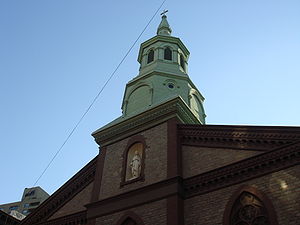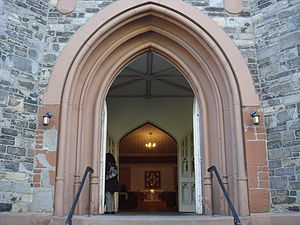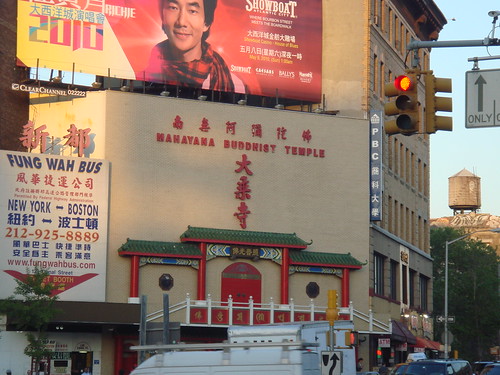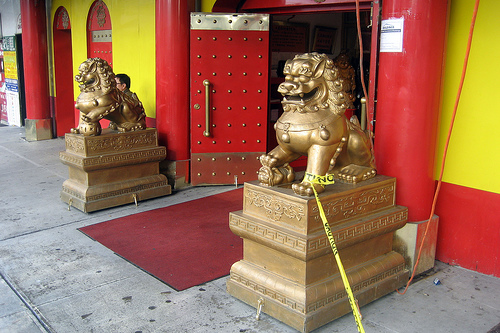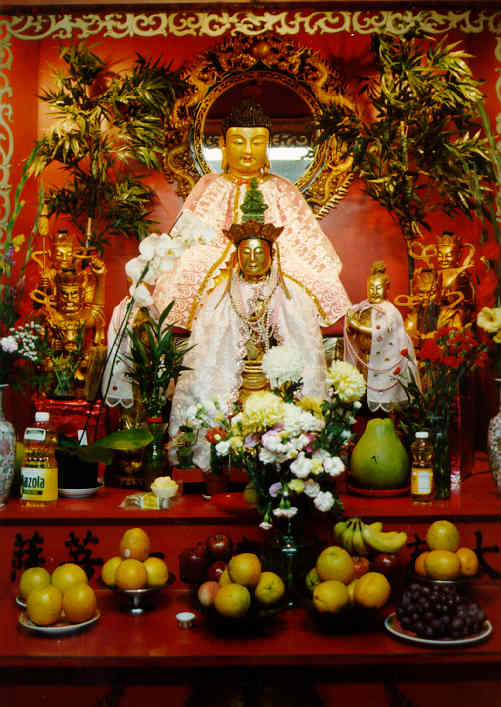Religious InstitutionsFrom Welcome to Chinatown NYCReligion is a very important part of Chinese life, and the Chinese communities in NY have adapted both Western and Eastern practices into their worship. Although most Chinese are Christians, traditional values that begun over 5,000 years ago are still present. Such traditions include the meanings attributed to jade. A simple google search for "religion in Chinatown NY" returns the result for Religion Gift, a store that promises to send along the spirit of your loved one for $280 plus and some food offerings. Churches and temples are very important to the New York Chinese community, and Buddhism and Taoism are practiced in storefronts across the street from churches [1], [2]. Due to the evolving nature of group interactions in NY, the Chinese community is slowly taking over earlier immigrant groups, such as Polish groups, by holding services once a week for Chinese parishioners. Transfiguration ChurchThe Transfiguration Church's regal architecture and copper steeple stand in sharp contrast with the tenement buildings surrounding Columbus Park. It is located on 29 Mott Street, and has been a vital community church since 1801. The Church served as a Zion Protestant Episcopal Church for the first fifty years after its inception. In 1853, due to the masses of impoverished immigrants settling in the nearby Five Points slum, the church was sold. It is the oldest Catholic Church building in New York City. The church used to serve as a place of worship for the Italian and Irish immigrants in the neighborhood, but it is now host to the largest Chinese Roman Catholic congregation in the United States. The Transfiguration Church offers mass in Cantonese, Mandarin, and English, and the signs are written primarily in Chinese. [1] [2]
St. Teresa's ChurchLike the Transfiguration Church, St. Teresa's Church has also reflected the population of the surrounding neighborhood over its lifetime. It was built in 1863 and has had a history filled with turmoil ever since. The church used to serve as a center for Catholic education as well as a place of worship. The classes were taught in a neighboring building until 1942 when the building was condemned and demolished. The church was always poor, and has closed and reopened under various sisterhoods and brotherhoods over the past century. The [Cabrini Sisters], who currently run the parish, offer immigrant services to accommodate the new immigrants in the community. In 1995, the roof of the church collapsed and forced the congregation to neighboring worship places. The church has now been rebuilt and, despite its lack of funds, continues to serve the Catholic community in Chinatown and the Lower East Side. They offer mass in three languages (English, Chinese, and Spanish) to better serve the current community. [3]
BuddhismBeing both the largest religion in China, Buddhism also has a noticeable presence in the Chinese communities of New York. This is evident from many souvenir shops that sell a number of Buddhist accessories and statues, as well as the small Buddhist shrines set up in the backs of restaurants. Mahayana Buddhist TempleThere are several Buddhist temples located in Chinatown. The most well known temple is The Mahayana Buddhist Temple, which is located right at the foot of the Manhattan Bridge off Canal Street. This red and gold pagoda-themed building is guarded by two bronze lion statues, standing ever vigilant at the front entrance. The temple’s vestibule houses a large urn filled with burning incense. Visitors can drop a dollar into the slot and reach down for their fortune. Next to this urn is a small shrine devoted to Guan-Ying, Bodhisattva of mercy and compassion. The ceiling and walls of the temple are covered with illustrations depicting the story of Buddha in both Chinese and English, decorated with bamboo and jade pieces. The main floor of the temple houses a magnificent, sixteen-foot statue of the Buddha. He sits calmly on a lotus, surrounded by a garden of red and gold flowers and a series of illuminated pagodas on either side. A large neon blue halo with a flame pattern lights the statue from behind, while the stainless floor reflects the image of the statue below.
References Eastern States Buddhist TempleThe Eastern States Buddhist Temple, located on 64 Mott Street between Canal and Bayard, is a smaller, more casual prayer space.
References References
|

